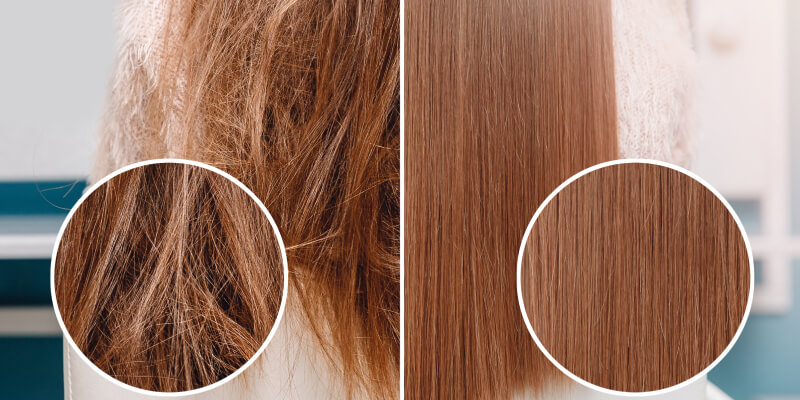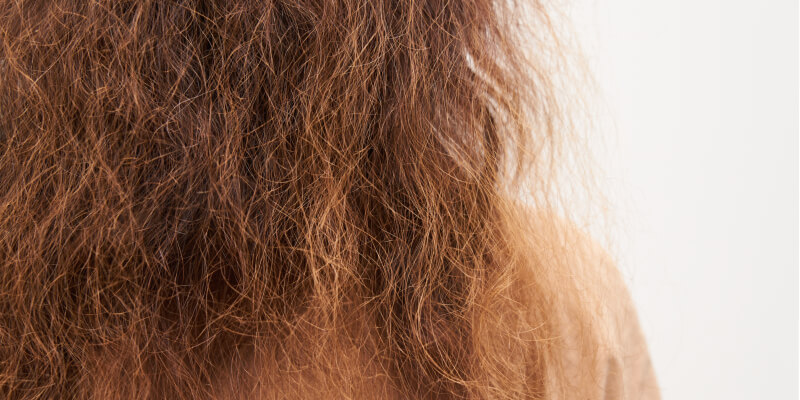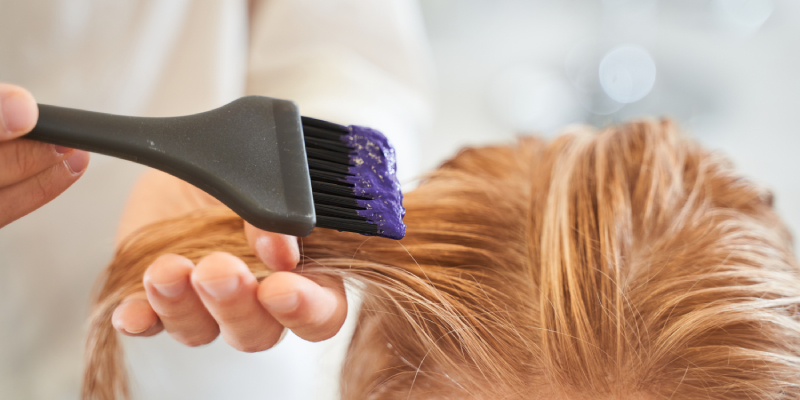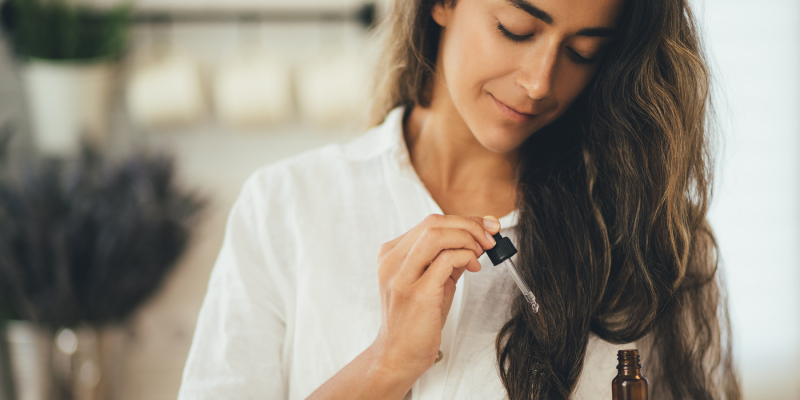Bad hair day or damaged hair? Often, the two go hand in hand. If your hair looks dull, frizzy or is generally misbehaving, chances are it’s a little damaged. And, while this isn’t the news many of you will want to read, hair damage is generally permanent. No amount of conditioners or serums will restore your locks to their smooth, shiny state once the cuticle has cracked because damaged hair is simply a collection of dead cells.
The only true cure for a damaged mane is time and a pair of scissors. However, with the correct haircare routines and targeted treatments, you can begin to restore the cuticle and minimise your risk of damaged hair in the future. After years of running a hair salon in Milton Keynes, we’ve helped countless clients manage their damaged hair and restore it to its former glory. So, in this article, we’ll use our expertise to help you understand how to repair damaged hair and maintain healthy locks.
Glow-Up Guide: How To Repair Damaged Hair
Healthy hair isn’t just one of the best ways to boost self-confidence. It’s an excellent indicator of your overall health. Vibrant, hydrated, and smooth hair means your body produces enough vitamins and nutrients to benefit all areas of your well-being. So, while a glow-up might be your main motivator, there are plenty more reasons to try and achieve healthy hair.
A 2022 study by Dyson found over 70% of people perceive that they have damaged hair. And, as there are so many ways to damage the cuticle, it’s easy to see why. From over-styling to spending too much time in the sun, it’s impossible to manage all the risks to your hair consistently, but with our glow-up guide, you can find a balance that works with your lifestyle.
- What Does Damaged Hair Look Like?
- Understanding Where You Went Wrong
- How To Ease Existing Damage
- How To Limit Further Damage

What Does Damaged Hair Look Like?
Damaged hair takes on many forms, each indicating a different root cause. Knowing the signs of damaged hair won’t just help you understand when intervening action is needed; it’ll mean you can narrow down the potential issues with your haircare routine or lifestyle.
Split Ends
Split ends are found at the oldest part of the hair shaft, at the very bottom of each strand. They occur when the hair becomes dry and brittle, forcing the hair fibres to splinter, leaving them frayed and at risk of breaking off altogether. Having a few split ends is normal, but too many is a symptom of unhealthy hair. If left untreated, split ends can travel up the strand, creating an uneven appearance and impacting the visual appeal of your hair.
Frizz
If you’ve got straight hair and have noticed it’s frizzier than usual, it could be a sign of ongoing damage. Frizz and flyaways are common in individuals with curly or wavy hair but indicate damage to the cuticle in straight hair. Frizz is caused by a lack of moisture in your hair, so it’s far more common in the summer months when the heat dries out your locks. In humid conditions, your hair seeks out the moisture in the air, causing it to expand and become even frizzier.
Dull And Dry
When hair loses its shine, it’s a clear indicator that it lacks the nutrients it needs to thrive. Without these nutrients, the hair is easily damaged, and restoring it to a healthy condition becomes increasingly difficult. Hair products with lots of chemicals, over-styling, and exposure to pollutants commonly lead to dry and dull hair.

Understanding Where You Went Wrong
The first step towards repairing your damaged hair is understanding where you went wrong in the first place. There are countless ways to damage your hair, some more obvious than others, but by understanding the root cause, you can develop an effective plan to restore your locks. Let’s look at some of the most common ways hair gets damaged:
Dye
As tempting as a new hair colour can be, dyeing your hair at home can have serious consequences. Shop-bought dyes usually use a range of chemicals to change the shade of your hair. These chemicals strip the hair of its natural moisture, making it coarse to the touch. While dyeing your hair at a salon can be more expensive, it’s the best way to preserve the health of your hair, as a professional colourist will use products and methods that minimise damage.
Bleach
Drastic colour changes often require bleaching before dyeing. Strand by strand, bleach removes your natural hair colour. It forces your hair to swell to reach each stand’s inner parts. It then dissolves the melanin that gives your hair pigment. This process is as harmful as it sounds, leaving the hair dry, porous and brittle. Bleach also permanently alters the structure of your hair, reducing strength and elasticity.
Heat Exposure
Heat styling tools or lengthy exposure to the sun can ‘cook’ hair fibres. High temperatures lead to raised cuticles and porous hair, making it more prone to damage.
Lack Of Maintenance
Lengthy periods between haircuts can lead to dry split ends, which are impossible to put back together. Regular haircuts are the best way to ensure your hair stays healthy and well-maintained. For maximum benefit, make sure you follow good hair care practices between trims so the damage is minimal when it comes to your appointment at the salon. When you arrange an appointment at our hairdressers in Milton Keynes, our stylists will help advise you on the best way to maintain healthy hair following your haircut.

How To Ease Existing Damage
While it’s impossible to repair hair once it’s damaged, there are ways to restore moisture and improve its visual appeal. Many oils have been found to rehydrate and smooth a damaged cuticle. For example, studies have shown that olive oil helps soften the hair and replenish much-needed moisture. Additionally, the molecules in coconut oil are small enough to penetrate the outer cuticle and provide hydration from the inside. Almond, jojoba, geranium and many more oils have all been found to drastically improve the moisture retention of damaged hair and boost its appearance.
Similarly, hair masks won’t repair damaged hair, but they will load it with moisture and revitalise how it looks. If you’re worried about the chemicals in hair masks and conditioners, why not try a more natural method? People in China and Japan have been using rice water to promote healthy hair for generations. Inositol, an ingredient found in the water usually discarded after cooking rice, has been shown to penetrate damaged hair and repair it from the inside out.
Alternatively, if you’re in the process of restoring your damaged hair and are looking for a way to maintain its visual appeal, hair extensions could be the ideal solution. At Lacy Locks, we specialise in hair extensions in Milton Keynes. Our team is trained in all extension installation methods, providing a vibrant, voluminous, healthy-looking finish. Learn more about the different types of extensions we fit and which is best for your hair type in our previous article.

How To Limit Further Damage
In order to start repairing your hair, you’ll need to prevent any further damage. This means making changes to parts of your hair care routine and lifestyle that could have a detrimental effect on the health of your hair.
If your damaged hair can be attributed to dyeing it, extending the time between dye jobs is the best way to prevent further harm. If possible, wait 8-10 weeks or longer between touch-ups. Additionally, try to stay within three shades of your natural colour, prioritising darker tones as experts say it’s easier for your hair to handle that kind of change.
If bleach is to blame for your hair’s damage, the restoration process will require a lot more work. The damage will increase each time you use bleach, so the less you do it, the better. You should also use sun protection or avoid the sun as much as possible because bleached hair is especially susceptible to UV damage.
The fix for heat-related damage is simple: reduce your exposure to heat. That means blow-drying from a distance and air drying where possible. Blow dryers are one of the top offenders in damaging hair, so to use them safely, you should hold them at least 15 centimetres from your hair. Air drying is the most hair-friendly method of drying and is done by wrapping your hair in a towel to pull out the excess water before letting it hang free. Don’t rub your hair with the towel, as this will cause further damage through friction.

Time To Rebuild
Now, you’re armed with all the information you need to turn your hair from damaged to dreamy. As explained, hair damage is permanent, and there’s no easy fix, but with these methods, you can ensure a hitch-free rebuilding process. If you’re still unsure about the cause of your damaged hair or want to further discuss the best methods of repair, arrange an appointment at our hair salon in Milton Keynes. Your Lacy Locks stylist will explain the damage and help you understand the best ways to maintain your hair type. Get in touch and start your glow-up today!

